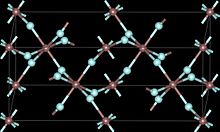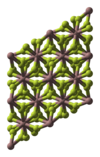This is an old revision of this page, as edited by Graeme Bartlett (talk | contribs) at 20:57, 19 November 2021 (more ids and hazard upgrade). The present address (URL) is a permanent link to this revision, which may differ significantly from the current revision.
Revision as of 20:57, 19 November 2021 by Graeme Bartlett (talk | contribs) (more ids and hazard upgrade)(diff) ← Previous revision | Latest revision (diff) | Newer revision → (diff) | |
 | |
| Names | |
|---|---|
| Other names gallium trifluoride | |
| Identifiers | |
| CAS Number | |
| 3D model (JSmol) | |
| ChemSpider | |
| ECHA InfoCard | 100.029.094 |
| EC Number |
|
| PubChem CID | |
| UNII | |
| CompTox Dashboard (EPA) | |
InChI
| |
SMILES
| |
| Properties | |
| Chemical formula | GaF3 |
| Molar mass | 126.718 g/mol |
| Appearance | white powder |
| Density | 4.47 g/cm |
| Melting point | 800 °C (1,470 °F; 1,070 K) |
| Boiling point | 1,000 °C (1,830 °F; 1,270 K) |
| Solubility in water | 0.0002 g/100 mL |
| Structure | |
| Crystal structure | Rhombohedral, hR24 |
| Space group | R-3c, No. 167 |
| Hazards | |
| GHS labelling: | |
| Pictograms | 
|
| Signal word | Warning |
| Hazard statements | H302, H312, H332 |
| Precautionary statements | P261, P264, P270, P271, P280, P301+P312, P302+P352, P304+P312, P304+P340, P312, P322, P330, P363, P501 |
| NFPA 704 (fire diamond) |
 |
| Except where otherwise noted, data are given for materials in their standard state (at 25 °C , 100 kPa).
| |
Gallium(III) fluoride (GaF3) is a chemical compound. It is a white solid that melts under pressure above 1000 °C but sublimes around 950 °C. It has the FeF3 structure where the gallium atoms are 6-coordinate. GaF3 can be prepared by reacting F2 or HF with Ga2O3 or by thermal decomposition of (NH4)3GaF6. GaF3 is virtually insoluble in water. Solutions of GaF3 in HF can be evaporated to form the trihydrate, GaF3·3H2O, which on heating gives a hydrated form of GaF2(OH). Gallium(III) fluoride reacts with mineral acids to form hydrofluoric acid.
 |
 |
 |
|
| view along the a axis | view along the c axis | Ga coordination | F coordination |
References
- Greenwood, Norman N.; Earnshaw, Alan (1997). Chemistry of the Elements (2nd ed.). Butterworth-Heinemann. ISBN 978-0-08-037941-8.
- ^ Anthony John Downs, (1993), Chemistry of Aluminium, Gallium, Indium, and Thallium, Springer, ISBN 978-0-7514-0103-5
Further reading
- Barrière, A.S.; Couturier, G.; Gevers, G.; Guégan, H.; Seguelond, T.; Thabti, A.; Bertault, D. (1989). "Preparation and characterization of gallium(III) fluoride thin films". Thin Solid Films. 173 (2): 243. Bibcode:1989TSF...173..243B. doi:10.1016/0040-6090(89)90140-5.
| Gallium compounds | |||
|---|---|---|---|
| Gallium(−V) | |||
| Gallium(I) | |||
| Gallium(II) | |||
| Gallium(I,III) | |||
| Gallium(III) |
| ||
This inorganic compound–related article is a stub. You can help Misplaced Pages by expanding it. |